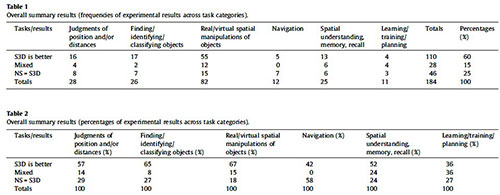What is 3D Good For?
By Arthur Berman
DisplayDaily
 The title of this Display Daily article is drawn from the text of a recent publication entitled “Stereoscopic 3D displays and human performance: A comprehensive review.” To produce an answer to the question in the title, the authors “reviewed the body of literature concerning the performance implications of stereoscopic 3D (S3D) displays versus non-stereo displays.”
The title of this Display Daily article is drawn from the text of a recent publication entitled “Stereoscopic 3D displays and human performance: A comprehensive review.” To produce an answer to the question in the title, the authors “reviewed the body of literature concerning the performance implications of stereoscopic 3D (S3D) displays versus non-stereo displays.”
The work was conducted by a team from the 711th Human Performance Wing/RHCV, US Air Force Research Laboratory (Dayton, Ohio). The team was headed by Engineering Research Psychologist John P. McIntire.
I now paraphrase in explaining that, in producing their report, the authors summarized the results of over 160 publications describing over 180 experiments spanning 51years. The research contained in these articles included human factors psychology/engineering, human–computer interaction, vision science, visualization and medicine. Publications were included in the study if they described at least one task with a performance based experimental evaluation of an S3D display versus a non-stereo display under comparable viewing conditions.
Each study was classified according to the primary experimental task or tasks reported in the study. The categories were as follows:
- Judgments of positions and/or distances.
- Finding, identifying or classifying objects.
- Spatial manipulations of real or virtual objects.
- Navigation.
- Spatial understanding, memory or recall.
- Learning, training or planning.
The results of the study are to be published in Displays, Volume 35, Issue 1, January 2014, Pages 18–26. A copy of the article is available for purchase on-line and can be found here.
The principle results of the study can be summarized in the two tables presented below (click to enlarge).
Highlights drawn from these results included the following:
- S3D display viewing improved performance in 60 percent of experiments.
- In 15 percent of the experiments, S3D either showed a marginal benefit or the results were mixed or unclear.
- In only 25 percent of experiments, S3D displays clearly offered no benefit over 2D viewing.
- Stereoscopic 3D displays were most helpful for the spatial manipulation of objects and for finding/identifying/classifying objects or imagery.
Based on their study of the literature, the authors go on to suggest that future researchers into 3D human factors may benefit from considering the following advice in conducting and sharing their work:
- Clearly report the magnitudes of binocular disparity in units of visual angle that are induced or experimentally manipulated in the 3D conditions.
- Clarify which monocular depth cues are visible within the experimental tasks.
- Care should be taken to describe the particular experimental display hardware utilized as well as the types of S3D displays that were tested.
- The binocular vision and depth perception capabilities of viewers should be thoroughly examined and reported.
- Measure and report any presence of discomfort attributable to their experimental manipulations.
Bottom line: This report provides a valuable synthesis and analysis of the literature on 3D human factors.



